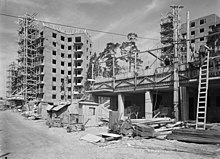
Back قالب منزلق Arabic Gleitbauweise German Encofrado deslizante Spanish قالبهای لغزنده Persian Coffrage glissant French Cassaforma semi-rampante Italian Glijbekisting Dutch Glidformsgjutning Swedish 滑模 ZH-YUE


Slip forming, continuous poured, continuously formed, or slipform construction is a construction method in which concrete is placed into a form that may be in continuous motion horizontally, or incrementally raised vertically.
In horizontal construction, such as roadways and curbs, the weight of the concrete, forms, and any associated machinery is borne by the ground. In vertical construction, such as bridges, towers, buildings, and dams, forms are raised hydraulically in increments, no faster than the most recently poured concrete can set and support the combined weight of the concrete, forms, and machinery, and the pressure of concrete consolidation.[1]
Slipforming enables continuous, non-interrupted, cast-in-place, cold joint- and seam-free concrete structures that have performance characteristics superior to those of piecewise construction using discrete form elements.[citation needed]
- ^ Nawy, Concrete Construction Engineering Handbook, 2008, p. 10—33.